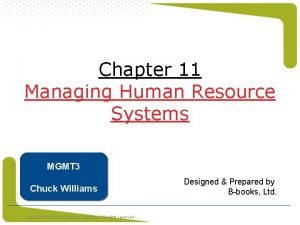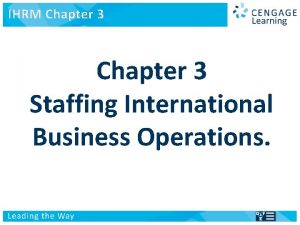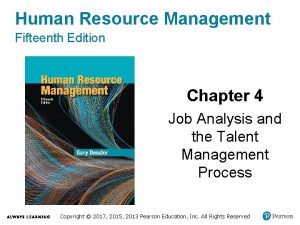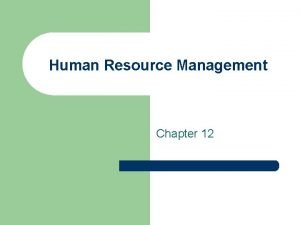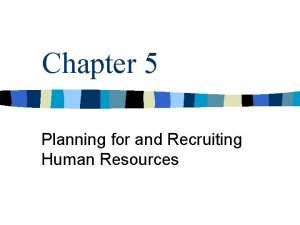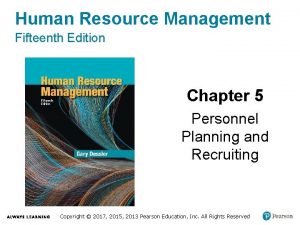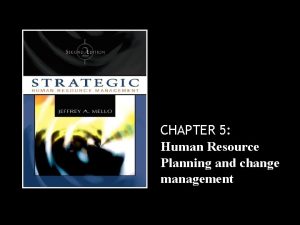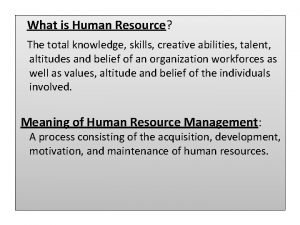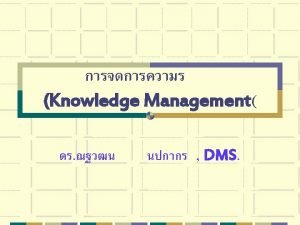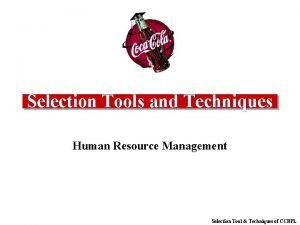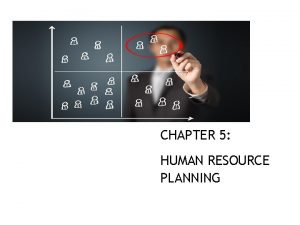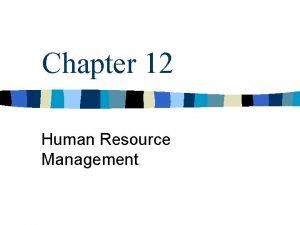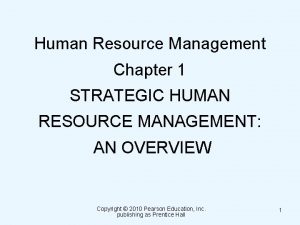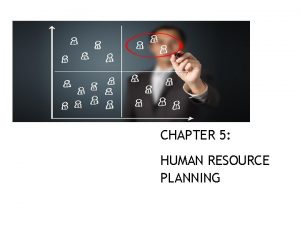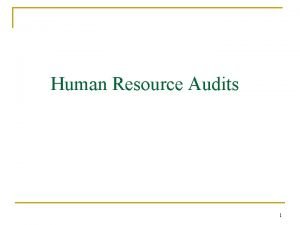Gatewood HUMAN RESOURCE SELECTION 8 E CHAPTER 14





































- Slides: 37

Gatewood HUMAN RESOURCE SELECTION, 8 E CHAPTER 14 COUNTERPRODUCTIVE WORK BEHAVIORS © 2017 Cengage Learning® May not be scanned, copied or duplicated, or posted to a publicly accessible website, in whole or in part, except for use as permitted in a license distributed with a certain product or service or otherwise on a password-protected website or school-approved learning management system for classroom use.

Testing for Counterproductive Work Behaviors � Integrity testing is useful in testing for certain undesirable work behaviors But there is some disagreement regarding the strength of the relationships between integrity test scores and certain undesirable employee behaviors � “Bad” behaviors are categorized as counterproductive work behaviors (CWBs) � © 2017 Cengage Learning® May not be scanned, copied or duplicated, or posted to a publicly accessible website, in whole or in part, except for use as permitted in a license distributed with a certain product or service or otherwise on a password-protected website or school-approved learning management system for classroom use.

Testing for Counterproductive Work Behaviors (2) CWBs represent a wide array of illegal or unethical conduct: � Theft of money, equipment, other resources � Illicit drug use � Violence � Cursing at others � Sabotaging company equipment � Purposely doing work incorrectly � Of growing concern is employee theft � © 2017 Cengage Learning® May not be scanned, copied or duplicated, or posted to a publicly accessible website, in whole or in part, except for use as permitted in a license distributed with a certain product or service or otherwise on a password-protected website or school-approved learning management system for classroom use.

Polygraph Testing � A polygraph (lie detector) is a machine that measures physiological responses of examinees that accompany their verbal responses to direct questions � This data, and opinion of polygraph operator, used to evaluate truthfulness regarding the respondent’s past or present behaviors � Employee Polygraph Protection Act of 1988 restricts use of the polygraph for selection to police work, security, and the like © 2017 Cengage Learning® May not be scanned, copied or duplicated, or posted to a publicly accessible website, in whole or in part, except for use as permitted in a license distributed with a certain product or service or otherwise on a password-protected website or school-approved learning management system for classroom use.

Polygraph Testing (2) � Procedures � A pretest discussion with examinee that covers all questions in the test to ensure understanding � Polygraph is attached, exam conducted; questions may be repeated � Three types of questions: � Irrelevant, non-emotional questions � Emotional control questions � Questions about behavior of interest © 2017 Cengage Learning® May not be scanned, copied or duplicated, or posted to a publicly accessible website, in whole or in part, except for use as permitted in a license distributed with a certain product or service or otherwise on a password-protected website or school-approved learning management system for classroom use.

Polygraph Testing (3) � Limitations � Reactions other than guilt can trigger an emotional response � There a variety of countermeasures examinees can use to avoid detection: � Tensing muscles, biting tongue, flexing toes, etc. � Mental countermeasures like relaxation � Major drawback to polygraph is frequency of false-positive results (Example: 68%) � There also false negatives © 2017 Cengage Learning® May not be scanned, copied or duplicated, or posted to a publicly accessible website, in whole or in part, except for use as permitted in a license distributed with a certain product or service or otherwise on a password-protected website or school-approved learning management system for classroom use.

Integrity Testing � Paper-and-Pencil Integrity Tests � These have been used for 65 years � These are legal under federal law, but a few states have prohibited them or restricted use � Integrity tests aimed toward identifying job applicants predisposed to engage in counterproductive behaviors; two forms: � Overt integrity tests directly asking for information � Personality-oriented measures, inventories measuring traits linked to certain CWBs © 2017 Cengage Learning® May not be scanned, copied or duplicated, or posted to a publicly accessible website, in whole or in part, except for use as permitted in a license distributed with a certain product or service or otherwise on a password-protected website or school-approved learning management system for classroom use.

Integrity Testing (2) � Overt Integrity Tests � Examples include the Personnel Selection Inventory, the Reid Report, the Stanton Survey � Research shows the typical employee-thief: � (a) is more tempted to steal � (b) engages in many common rationalizations for theft � (c) would punish thieves less � (d) often thinks about theft-related activities � (e) attributes more theft to others � (f) shows more inter-thief loyalty � (g) is more vulnerable to peer pressure to steal © 2017 Cengage Learning® May not be scanned, copied or duplicated, or posted to a publicly accessible website, in whole or in part, except for use as permitted in a license distributed with a certain product or service or otherwise on a password-protected website or school-approved learning management system for classroom use.

Integrity Testing (2) � Personality-Oriented Measures � Idea for this test is that employee theft is just one element in a larger syndrome of antisocial behavior which may include dishonesty, theft, drug and alcohol abuse, vandalism, violence, more � Assumption is that there is a common personality pattern, and it can be identified � A subset of items are identified as an integrity scale, and these are used to measure the test-taker’s integrity � Test less transparent; reduces faking � Rejected applicants need not be rejected for dishonesty © 2017 Cengage Learning® May not be scanned, copied or duplicated, or posted to a publicly accessible website, in whole or in part, except for use as permitted in a license distributed with a certain product or service or otherwise on a password-protected website or school-approved learning management system for classroom use.

Table 14. 1 – Scales of the Hogan Personality Inventory © 2017 Cengage Learning® May not be scanned, copied or duplicated, or posted to a publicly accessible website, in whole or in part, except for use as permitted in a license distributed with a certain product or service or otherwise on a password-protected website or school-approved learning management system for classroom use.

Integrity Testing (3) � What We Know About Integrity Tests � Constructs Measured � Appropriate to think of integrity tests as measuring three of the Big-Five Factors � Conscientiousness � Agreeableness � Emotional stability � Integrity tests a hierarchical model with 3 levels � Integrity tests can measure at all 3 levels © 2017 Cengage Learning® May not be scanned, copied or duplicated, or posted to a publicly accessible website, in whole or in part, except for use as permitted in a license distributed with a certain product or service or otherwise on a password-protected website or school-approved learning management system for classroom use.

Integrity Testing (4) � What We Know About Integrity Tests (2) � Variables Related to Integrity Tests � Personality-oriented tests correlated more highly with the Big. Five dimensions than overt tests � Recent work postulates a sixth personality dimension: Honesty -Humility, which measures fairness, sincerity, lack of conceit and lack of greed (HEXACO) � The Six-Factor model outperformed the Five-Factor � The relationship between integrity measures and cognitive ability may depend on the factors measured © 2017 Cengage Learning® May not be scanned, copied or duplicated, or posted to a publicly accessible website, in whole or in part, except for use as permitted in a license distributed with a certain product or service or otherwise on a password-protected website or school-approved learning management system for classroom use.

Table 14. 2 – Criteria Measures Correlated with Employee Reliability. . © 2017 Cengage Learning® May not be scanned, copied or duplicated, or posted to a publicly accessible website, in whole or in part, except for use as permitted in a license distributed with a certain product or service or otherwise on a password-protected website or school-approved learning management system for classroom use.

Integrity Testing (5) � What We Know About Integrity Tests (3) � Relationship Between Overt and Personality-Oriented Tests � Do these measure the same constructs? � Research shows: � The integrity tests showed a great deal of similarity in what they measured � Overt tests correlated more highly with honesty and supervision attitudes; personality tests correlated more highly with self/impulse control, home life/upbringing, risk taking, diligence and emotional stability © 2017 Cengage Learning® May not be scanned, copied or duplicated, or posted to a publicly accessible website, in whole or in part, except for use as permitted in a license distributed with a certain product or service or otherwise on a password-protected website or school-approved learning management system for classroom use.

Integrity Testing (5) � What We Know About Integrity Tests (3) � Validity � Determining the validity of integrity tests is difficult; which criterion variable should we correlate? � Many CWBs not reported in employee records � Self-reporting may not be an accurate measure � Conclusions from a number of studies: � Integrity tests valid for prediction of theft, general CWBs and work performance � Table 14. 3 shows a meta-analysis © 2017 Cengage Learning® May not be scanned, copied or duplicated, or posted to a publicly accessible website, in whole or in part, except for use as permitted in a license distributed with a certain product or service or otherwise on a password-protected website or school-approved learning management system for classroom use.

Table 14. 3 – …Meta-Analysis Results of Integrity Test Validities… © 2017 Cengage Learning® May not be scanned, copied or duplicated, or posted to a publicly accessible website, in whole or in part, except for use as permitted in a license distributed with a certain product or service or otherwise on a password-protected website or school-approved learning management system for classroom use.

Integrity Testing (6) � What We Know About Integrity Tests (3) � Usefulness of Integrity Tests � Harris sought to estimate in dollars, the payoff of using integrity tests in pre-employment testing � Assuming a certain cost and applicant pass rate, use of an integrity test would lead, on average, to a savings of $201, 470 per 1, 000 job applicants © 2017 Cengage Learning® May not be scanned, copied or duplicated, or posted to a publicly accessible website, in whole or in part, except for use as permitted in a license distributed with a certain product or service or otherwise on a password-protected website or school-approved learning management system for classroom use.

Integrity Testing (7) � What We Know About Integrity Tests (4) � Usefulness of Integrity Tests (2) � False Positives – 40 to 70% of applicants commonly fail integrity tests, and a large number of those may be incorrectly classified � It may be in the interest of the publisher to avoid false negatives, so may set low cutoff score � It may be in the interests of the employer to avoid false positives, so may set high cutoff score � Because of implications of false positives, use of a personality inventory better than integrity test © 2017 Cengage Learning® May not be scanned, copied or duplicated, or posted to a publicly accessible website, in whole or in part, except for use as permitted in a license distributed with a certain product or service or otherwise on a password-protected website or school-approved learning management system for classroom use.

Integrity Testing (8) � What We Know About Integrity Tests (5) � Usefulness of Integrity Tests (3) � Faking may be especially possible for overt tests that directly ask about attitudes and conduct, but faking does not seem to make a difference in the validity of the test � But this may not indicate the full effect of distortion on selection devices © 2017 Cengage Learning® May not be scanned, copied or duplicated, or posted to a publicly accessible website, in whole or in part, except for use as permitted in a license distributed with a certain product or service or otherwise on a password-protected website or school-approved learning management system for classroom use.

Legal Issues in Integrity Testing Under ADA: � personality inventories designed to detect mental health issues are a prohibited medical exam (Ex: MMPI) � Tests may not include questions about previous drug or alcohol use � Other Stuff � Recent attempts to change format of integrity tests to biodata questionnaires, forced-choice response, etc. ; hard to see an advantage � © 2017 Cengage Learning® May not be scanned, copied or duplicated, or posted to a publicly accessible website, in whole or in part, except for use as permitted in a license distributed with a certain product or service or otherwise on a password-protected website or school-approved learning management system for classroom use.

Drug Testing � Drug & alcohol use of concern to employers since 1960’s Drug testing increasingly common, especially for those with safety sensitive jobs or government contracts � Drug use: � negatively associated with job performance � Positively correlated with accidents, injuries, absences, involuntary turnover, job-withdrawal behaviors � © 2017 Cengage Learning® May not be scanned, copied or duplicated, or posted to a publicly accessible website, in whole or in part, except for use as permitted in a license distributed with a certain product or service or otherwise on a password-protected website or school-approved learning management system for classroom use.

Drug Testing (2) � Any usage information gathered from self-reporting may be understated � One 2006 study found: � 1. Marijuana used by 11. 3% of workforce � 2. Cocaine used by 1. 0% of workforce � 3. One of four psychotherapeutic drugs used by 4. 9% of the workforce � 4. Marijuana use had caused impairment to 10. 6% of workforce � 5. Cocaine use had impaired 0. 9% of workforce � 6. One of four psychotherapeutic drugs impaired 2. 2% © 2017 Cengage Learning® May not be scanned, copied or duplicated, or posted to a publicly accessible website, in whole or in part, except for use as permitted in a license distributed with a certain product or service or otherwise on a password-protected website or school-approved learning management system for classroom use.

Drug Testing Methods � Paper-and-Pencil Tests Overt types ask such questions as: � Do you think it is okay for workers to use “soft” drugs at work if it does not cause poor job performance? � In past 6 months, how often have you used marijuana at work? � In past 6 months, have you brought cocaine to work even though you did not use it at work? � Almost no research on validity of this test � © 2017 Cengage Learning® May not be scanned, copied or duplicated, or posted to a publicly accessible website, in whole or in part, except for use as permitted in a license distributed with a certain product or service or otherwise on a password-protected website or school-approved learning management system for classroom use.

Drug Testing Methods � Urine Tests Used most often, first used in 1960 s, and continues to present day � Positive workplace tests for cocaine and marijuana have fallen, while abuse of prescription drugs (pain killers) has risen � Urine tests are: � (a) Relatively inexpensive � (b) results returned quickly (24 hrs) � (c) testing convenient for applicant � © 2017 Cengage Learning® May not be scanned, copied or duplicated, or posted to a publicly accessible website, in whole or in part, except for use as permitted in a license distributed with a certain product or service or otherwise on a password-protected website or school-approved learning management system for classroom use.

Drug Testing Methods � Hair Analysis � Samples of hair including the root are taken from applicants to be tested � More expensive, but use rising � Drug use can be detected over a longer period of time than urine testing � Each inch of hair shows usage for 90 days � For cannabis, 1 to 3 months � Oral Fluid Tests � Oral swab on inside of check; saliva analyzed for drugs � Barring lab error, this test is always accurate © 2017 Cengage Learning® May not be scanned, copied or duplicated, or posted to a publicly accessible website, in whole or in part, except for use as permitted in a license distributed with a certain product or service or otherwise on a password-protected website or school-approved learning management system for classroom use.

Accuracy of Chemical Tests � Chemical tests should be completely accurate � False positives may occur in an initial test, but should be eliminated by follow-up test � But these tests have limitations: � Positive result means only presence of drug above threshold level set for detection � Does not determine how much of the drug was used, how frequently, how long ago, the circumstances or the level of impairment in performance � People differ in absorption, metabolism and tolerance � Not correct to assume that presence of drug means it affected performance © 2017 Cengage Learning® May not be scanned, copied or duplicated, or posted to a publicly accessible website, in whole or in part, except for use as permitted in a license distributed with a certain product or service or otherwise on a password-protected website or school-approved learning management system for classroom use.

Legal Issues in Pre-Employment Drug Testing � Major questions about drug testing: � 1. it represents an invasion of privacy � True, but only an issue if the employer is a governmental institution � 2. it constitutes unreasonable search & seizure � Limited application to private employers; but does apply to governmental institutions � 3. is a violation of due process � If authorized, professionally conducted testing not a violation � 4. drug users are protected under the ADA � 5. Testing may violate the Civil Rights Act � 6. Testing my violate the National Labor Relations Act © 2017 Cengage Learning® May not be scanned, copied or duplicated, or posted to a publicly accessible website, in whole or in part, except for use as permitted in a license distributed with a certain product or service or otherwise on a password-protected website or school-approved learning management system for classroom use.

Legal Issues in Pre-Employment Drug Testing � Major questions about drug testing: � 4. drug users are protected under the ADA � ADA protects former drug users in rehabilitation, but excludes those currently using illegal drugs � 5. Testing may violate the Civil Rights Act � If unequal treatment occurs; also possible adverse impact � 6. Testing my violate the National Labor Relations Act � Under NLRA, collective bargaining agreement between employees and employer governs © 2017 Cengage Learning® May not be scanned, copied or duplicated, or posted to a publicly accessible website, in whole or in part, except for use as permitted in a license distributed with a certain product or service or otherwise on a password-protected website or school-approved learning management system for classroom use.

Guidelines for Drug-Testing with Job Applicants � 1. limit testing to positions which have major safety implications; testing may be required for those � 2. Private employers have more latitude unless they are subject to federal regulation � 3. Private employers have more flexibility with job applicants than with existing employees � 4. a combination of screening and confirmatory tests are necessary © 2017 Cengage Learning® May not be scanned, copied or duplicated, or posted to a publicly accessible website, in whole or in part, except for use as permitted in a license distributed with a certain product or service or otherwise on a password-protected website or school-approved learning management system for classroom use.

Guidelines for Drug-Testing with Job Applicants � 5. obtain written consent of the job applicant prior to testing; if positive result, allow person to explain; physician’s verification may be required; offer test by a lab of their choosing � 6. use standardized procedures, applied to all job applicants; do not exempt anyone � 7. program should be designed and reviewed periodically to ensure privacy for those tested; results must be kept confidential, especially from supervisors of existing employees, unless a defined need to know © 2017 Cengage Learning® May not be scanned, copied or duplicated, or posted to a publicly accessible website, in whole or in part, except for use as permitted in a license distributed with a certain product or service or otherwise on a password-protected website or school-approved learning management system for classroom use.

Genetic Testing � In 2003, Human Genome Project completed mapping of 25, 000 genes � Specific genes linked to certain diseases � For some diseases, link is strong; for others, weak � These results will continue to have important implications for health care and employment � Implications of genetic testing for employers when selecting among job applicants � Some employers have used genetic information to predict which most likely to miss work due to illness, disease © 2017 Cengage Learning® May not be scanned, copied or duplicated, or posted to a publicly accessible website, in whole or in part, except for use as permitted in a license distributed with a certain product or service or otherwise on a password-protected website or school-approved learning management system for classroom use.

Genetic Testing What is Genetic Testing? � Analysis of human DNA, chromosomes, proteins or metabolites that detect genotypes, mutations, more � Produces genetic information on � (a) individuals (for our purposes, job applicants) � (b) family members of these individuals � (c) the health histories of the individuals’ family members � Before federal law, based on genetic information: � employers denied jobs, fired existing employees � insurers denied coverage based on pre-existing condition © 2017 Cengage Learning® May not be scanned, copied or duplicated, or posted to a publicly accessible website, in whole or in part, except for use as permitted in a license distributed with a certain product or service or otherwise on a password-protected website or school-approved learning management system for classroom use.

Genetic Testing Legal Concerns Before protective laws were passed, employers refused to hire affected applicants to avoid health insurance costs � Health insurers used genetic information to deny insurance or refused to pay for treatment, calling genetic information a “preexisting” health condition � Case involving employers’ unauthorized testing of black applicants for sickle cell anemia raised issue in federal government � © 2017 Cengage Learning® May not be scanned, copied or duplicated, or posted to a publicly accessible website, in whole or in part, except for use as permitted in a license distributed with a certain product or service or otherwise on a password-protected website or school-approved learning management system for classroom use.

Genetic Testing Legal Concerns � The Genetic Information Nondiscrimination Act of 2008 (GINA) � Title II prohibits employers, and others from discriminating against employees & job applicants because of genetic information: � “An employer may never use genetic information to make an employment decision because genetic information is not relevant to an individuals’ current ability to work” � But complaints filed with the EEOC © 2017 Cengage Learning® May not be scanned, copied or duplicated, or posted to a publicly accessible website, in whole or in part, except for use as permitted in a license distributed with a certain product or service or otherwise on a password-protected website or school-approved learning management system for classroom use.

Table 14. 4 –Charges Filed by Employees & Job Applicants…GINA © 2017 Cengage Learning® May not be scanned, copied or duplicated, or posted to a publicly accessible website, in whole or in part, except for use as permitted in a license distributed with a certain product or service or otherwise on a password-protected website or school-approved learning management system for classroom use.

Table 14. 5 – Employer Mandates & Job Applicant Protection…GINA © 2017 Cengage Learning® May not be scanned, copied or duplicated, or posted to a publicly accessible website, in whole or in part, except for use as permitted in a license distributed with a certain product or service or otherwise on a password-protected website or school-approved learning management system for classroom use.

What’s Next? Neuroscience-Based Discrimination � Neuroscientists studying the brain have begun to examine relationships between neural circuits and development of diseases (Alzheimer’s), behaviors (racism, cooperativeness) and personality characteristics (extraversion, introversion) � One day, it will be possible to determine the probability that certain neural wirings are linked to specific outcomes � The same concerns arise here as did with genetic testing and the human genome © 2017 Cengage Learning® May not be scanned, copied or duplicated, or posted to a publicly accessible website, in whole or in part, except for use as permitted in a license distributed with a certain product or service or otherwise on a password-protected website or school-approved learning management system for classroom use.
 Cynthia gatewood
Cynthia gatewood Recruitment and selection in human resource management
Recruitment and selection in human resource management Hrm chapter 2
Hrm chapter 2 Chapter 9 human resources management
Chapter 9 human resources management Chapter 11 human resource management
Chapter 11 human resource management Human resource management chapter 1
Human resource management chapter 1 Human resources management chapter 1
Human resources management chapter 1 Human resource management 15th edition
Human resource management 15th edition Human resource management lecture chapter 1
Human resource management lecture chapter 1 Virtual assignment in ihrm
Virtual assignment in ihrm Human resource management chapter 4
Human resource management chapter 4 Chapter 12 human resource management
Chapter 12 human resource management Chapter 7 human resource management
Chapter 7 human resource management Chapter 7 human resource management
Chapter 7 human resource management Chapter 5 planning for and recruiting human resources
Chapter 5 planning for and recruiting human resources Human resource management chapter 4
Human resource management chapter 4 Project management chapter 4
Project management chapter 4 Example of replacement chart
Example of replacement chart Human resource management chapter 5
Human resource management chapter 5 Chapter 11 human resource management
Chapter 11 human resource management Resource leveling is the approach to even out the peaks of
Resource leveling is the approach to even out the peaks of Perbedaan antara resource loading dan resource levelling
Perbedaan antara resource loading dan resource levelling Balancing selection vs stabilizing selection
Balancing selection vs stabilizing selection Artificial selection vs natural selection
Artificial selection vs natural selection K selected
K selected Natural selection vs artificial selection
Natural selection vs artificial selection Difference between continuous and discontinuous variation
Difference between continuous and discontinuous variation Example of stabilizing selection
Example of stabilizing selection Clumped dispersion
Clumped dispersion Natural selection vs artificial selection
Natural selection vs artificial selection Two way selection and multiway selection
Two way selection and multiway selection Multiway selection in c
Multiway selection in c Mass selection and pure line selection
Mass selection and pure line selection Chapter 8 human needs and human development
Chapter 8 human needs and human development Chapter 8 human needs and human development
Chapter 8 human needs and human development Lev and schwartz model formula
Lev and schwartz model formula Zero-base forecasting
Zero-base forecasting Human resource development framework
Human resource development framework




